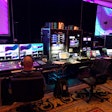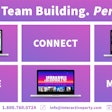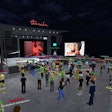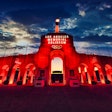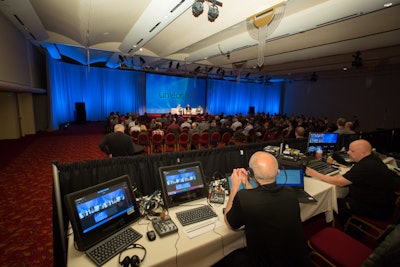
When the concept of recording and streaming sessions from conferences and meetings first developed several years ago, the focus was on the technology—how to configure the hardware and software to effectively capture and share event content. Now, as the technology has gotten smaller, easier to use, and more affordable, the audiovisual execution is the easy part. What takes thoughtful and strategic thinking, says Rob Lipps, Sonic Foundry executive vice president of worldwide sales and marketing, is determining what to do with the content.
“The ongoing challenge is, what is your content strategy?" he says. "Because you can record every session and the fact that very few people watched it doesn’t speak to the technology. So increasingly, we’ve become advisors to customers for things we’ve seen that actually provide consumption of content.”
We talked to Lipps about what planners should keep in mind as they develop a strategy to capture and share content from events. Here are his tips:
Establish Goals
For some planners, the goal is to increase the size of their event audience. So they want to stream sessions live because they want to do a blended event of people in person and online. There are others who just want record the content at the event and then sell access to that content throughout the year. It becomes a revenue source for them. And others want to use it for marketing: If customers are presenting during these sessions or content is coming from thought leaders, planners want to preserve that content and make it part of a 12-month "rolling thunder" marketing approach.
In each of those situations, what you record might be different. When we record Dreamforce, it’s 1,500 hours of content over four days. [Salesforce's] goal is to have as many people see it as quickly as possible, so they host it in our platform, they put it on YouTube, they put it on Vimeo, they put it everywhere. It’s just a saturation objective for them to get that content out there.
Use Content to Drive Engagement
Video can fuel six to 12 months of your content marketing, thought leadership, and social-media strategies. Repurpose educational sessions into webinars, turn customer interviews into case studies, breathe life into your e-newsletters and blog posts by embedding videos. Originally people thought recording and streaming your content would actually kill the in-person audience. It never happened. These events are facilitating interactions and relationships that just don’t happen when you are consuming content online. But the people seeing content online can get a feel for what the event looks like. You are disseminating the event’s culture. And in order to convert those viewers, make sure you include a call to action, like a link to registration for your next event.
Determine the Timing
If high viewership is your goal, the delay between the presentation of the content and its availability online is the biggest factor as to whether people watch. If you walk out of breakout session at 10 o’clock in the morning and that content is not made available to you for two weeks, I guarantee you’ll get 10 percent of the viewership than you would have had if that content had been available in 24 hours. The biggest viewership comes from people who walked out of the session that want to go back and rewatch something. And if you are waiting two weeks to do it, they almost never go back. Viewership spikes when content is available immediately.
If your goal is not immediate viewership or engagement of your event audience, you could record all that content and then implement it as part of a marketing strategy around the content in the next 12 months. The idea is then the event never really starts or ends; it just takes place over four or five days and the other 360 days it lives on in your strategy as to how you are drip-feeding that content out to people who went to the conference as well as to people who didn’t. We have customers tell us that the online content became their biggest marketing tool to get people to attend the event the following year. It becomes a test drive for the event.
Generate Revenue
Your conference is where the best, most valuable information is shared. Whether it’s a recent medical breakthrough, a product launch, or an educational session for certification or continuing education credits, if it is captured on video it’s a potential gold mine for your organization. If you are a member-driven association, sometimes your annual conference is your largest revenue-generator, but some people who can’t get there are willing to pay a fee to attend online. Where we capture conferences, a lot of associations are selling individual or bundles of content access, and now the association gets add-on revenue. The corporate market will generate revenue from videos, but it’s sponsored video. You can sell sponsorships for ad space in a video player. So there may be a banner saying, ‘This video brought to you by Cvent’ for example and then there’s a link to Cvent. You can tell sponsors, ‘You can get a banner in the venue hallway or you can get a banner in our player.’ All those things have eyeballs on them when it comes to sponsorship and cost recovery. And video is an area of real estate that doesn’t go away when the conference ends.
Engage Online
Integrate your video platform into a conference system, like the registration system or a user community—someplace where people are congregating. Maybe only 10 percent have been to your conference, but if you bring your conference into a community where 80 percent of your customers hang out, you can drive interest that way. During the conference, use social channels around the video to unite the online and in-person audiences. An embedded chat feature works great for this, as does a Twitter hashtag. Afterwards, create discussion groups in your online community on most-watched topics.
Learn From Experience
Create a plan to look at the data. Don’t just look at clicks—if someone clicked and only watched 90 seconds that doesn’t mean much. Look at who’s watching, how much they watched, and what they watched. That data takes the guesswork out of organizing next year’s conference. What speakers are the most popular, what topics are the most popular? If speakers were really popular online, you may want to invite them back next year and put them in a bigger room.









